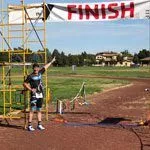Understanding Your On Pace Run Plan
by Matt Fitzgerald
This document is specific to the On Pace RPE plans. Be sure to read Intensity Guidelines for Running and Understanding Your TrainingPeaks Structured Workout Plan after reading this article.
The On Pace Run Plans from 80/20 Endurance were designed for the dual purpose of developing pacing skill in runners while at the same time preparing them to race at popular distances ranging from 5K to the marathon. Featuring the same, proven 80/20 intensity balance as our flagship running programs, these new plans complement Matt Fitzgerald’s book On Pace: Discover How to Run Every Race at Your Real Limit, which will be available soon.
Why pacing-focused training plans? Because pacing is the quintessential running skill. A well-developed pacing ability allows runners to get the most out of each workout and every race. But most runners aren’t very good at pacing—hence the need for training plans designed to teach this vital skill. Five key elements distinguish our On Pace plans from traditional run plans:
Effort-Based Runs
All of the runs in the On Pace plans are effort-based rather than pace-, power-, or heart-rate based. Specifically, a 10-point scale of perceived effort (or RPE) is used to prescribe intensity. Throughout each run you will “feel” your way to the correct intensity with the help of this scale. Use the following table to familiarize yourself with the “meaning” of each perceived effort rating.
| Perceived Effort Rating (RPE) | Feels Like | Corresponding Zone |
|---|---|---|
| 1 | N/A | N/A |
| 2 | Very, very easy | Zone 1 |
| 3 | Very easy | Zone 2 |
| 4 | Easy | |
| 5 | Comfortable | Zone X |
| 6 | Comfortably hard | Zone 3 |
| 7 | Hard | Zone Y |
| 8 | Very hard | Zone 4 |
| 9 | Very, very hard | Zone 5 |
| 10 | Maximal effort |
The main purpose of effort-based runs is to teach about body awareness. An expert pacer knows exactly how he or she ought to feel at any given point of a race, hence when to speed up, when to slow down, and when to hold steady. Relying too much on objective intensity metrics such as pace, power, and heart rate prevents runners from developing the body awareness that is required to pace expertly. It’s okay to pay attention to objective intensity metrics in some workouts (including the precision-splitting interval workouts below), but at the very least you should ignore them throughout all of your low-intensity runs (Foundation Runs, Recovery Runs, Endurance Runs, and Long Runs) while completing your On Pace plan.
Precision-Splitting Interval Workouts
Precision splitting entails trying to complete each repetition of a distance-based interval workout in the same time, down to the tenth of a second if possible. An alternative version of the method entails trying to cover exactly the same distance in each interval of a time-based interval workout. Precision splitting is a fun challenge that serves to improve runners’ ability to control their pace. Each On Pace plan contains at least one precision-splitting interval workout.
Novel Pacing Challenges
Novel pacing challenges are unusual workouts that test runners’ pacing ability by throwing “curveballs” at them. An example is acceleration runs, which require the runner to gradually accelerate from an easy jog to a full sprint over a period of several minutes.
Limit Testers
An underappreciated element of pacing skill is pain tolerance. A perfectly paced race is characterized by a steady increase in perceived effort culminating in absolute maximal exertion as the runner approaches the finish line. The higher a runner’s pain tolerance is, the greater their maximal exertion level will be at the end of the race. Limit testers are workouts that serve to increase runners’ pain tolerance by exposing them to brief maximal efforts. An example is stretch intervals, where the runner aims to cover slightly more distance in each interval of a set, completing the last interval at maximal effort.
Other Methods
Other methods of developing pacing skill, including body scanning and decision tracking, are sprinkled throughout our On Pace Run Plans. Full explanations of these methods can be found in the book.












































































